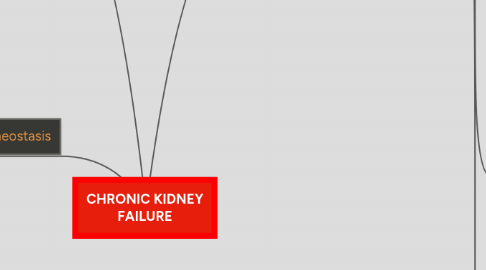
1. Relavant Assessments
1.1. Hypertension(B.P >150/100 mm of Hg
1.2. Glomerular Filtration Rate less than 60ml/min/1.73m2
1.3. Hematuria
1.4. Albuminuria
1.5. Edema
1.6. Oliguria
1.7. Impaired mental status
1.8. Weight Gain
1.9. Pulmonary congestion
1.10. Anorexia, Nausea and Vomiting
1.11. Pruritis
2. Kidney's Role in Homeostasis
2.1. Regulating Blood Pressure
2.2. Hormone regulation
2.3. Fluid and electrolyte balancing
2.4. Acid-base balancing
2.5. Excretion of wastes and toxins. Eg. Nitrorgenous waste
2.6. Maintaining and regulating pH level
2.7. Regulation of extracellular fluid volume
2.8. Regulation of osmolarity
3. Nursing Diagnosis
3.1. Fluid and Electrolyte imbalances related to secondary edema
3.1.1. Nursing Interventions
3.1.1.1. 1 Assess fluid status with daily weigh, balance input and output, skin turgor, vital signs.
3.1.1.2. 2 Limit your fluid intake. Rationale: R: fluid restriction can determine ideal body weight, urine output, and response to therapy.
3.1.1.3. 3 Explain to the patient and family about the liquid restrictions. Rationale: Understanding to increase cooperation of patients and families in the fluid restriction.
3.1.1.4. 4 Instruct the patient / teach the patient to record the use of fluid intake and output mainly. Rationale: To determine the balance of inputs and outputs.
3.2. Imbalanced Nutrition less than body requirements related to anorexia, nausea, vomiting.
3.2.1. Nursing Interventions
3.2.1.1. 1 Monitor the consumption of foods / liquids. Rationale: It helps in identifying nutritional deficiencies.
3.2.1.2. 2 Notice of nausea and vomiting. Rationale: It helps to understand fluid and electrolyte changes.
3.2.1.3. 3 Give food a little but often. Rationale: The portion of a smaller can increase food intake.
3.2.1.4. 4 Increase visits by people nearby during meals. Rationale: Provides transfer and improve the social aspects.
3.2.1.5. 5 Rationale: Lowering stomatitis oral discomfort and unwelcome taste in the mouth that can affect food intake.
3.3. Ineffective breathing pattern related to hyperventilation due to acid base imbalance
3.3.1. Nursing Interventions
3.3.1.1. 1 Auscultation of breath sounds, note the presence of crackles. Rationale: To find out the existence of the collection of secretions.
3.3.1.2. 2 Teach patient effective coughing and deep breathing. Rationale: Cleaning the airway and facilitate the flow oxygen
3.3.1.3. 3 Adjust the position as comfortable as possible. Rationale: To prevent breathing difficulty and shortness of breath
3.3.1.4. 4 Limit the movement Rationale: To reduce breathing difficulty and reduce cardiac work load.
3.4. Impaired skin Integrity related to pruritis from increased sodium in the blood
3.4.1. Nursing Interventions
3.4.1.1. 1 Inspection of the skin to change color, turgor, vascular, note the presence of redness. Rationale: It indicates area of poor circulation or damage that may lead to the formation of pressure sores / infections.
3.4.1.2. 2 Monitor fluid intake and hydration of the skin and mucous membranes. Rationale: Detecting the presence of dehydration or over-hydration affecting circulation and tissue integrity.
3.4.1.3. 3 Change positions as often as possible. Rationale: Reduce pressure on edema, poorly perfused tissue to reduce ischemia.
3.4.1.4. 4 Give skin care. Rationale: Reduce drying, skin tears.

